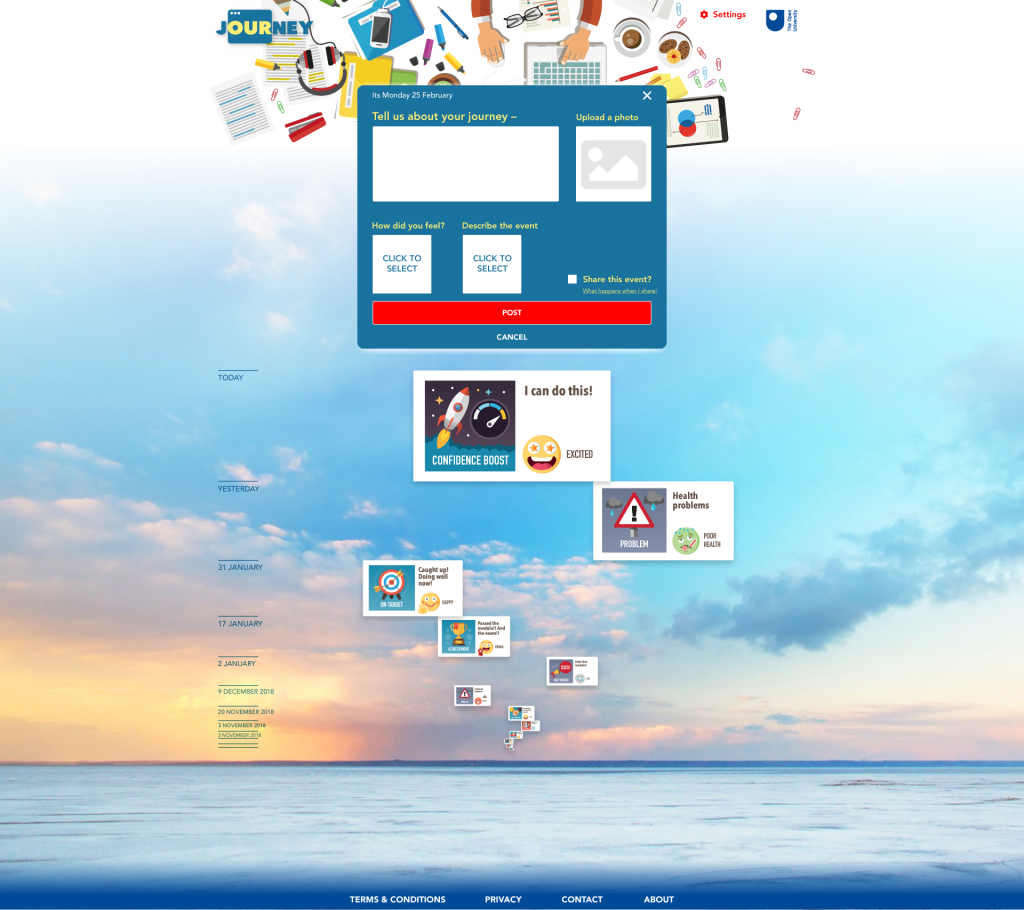Why does Our Journey exist?
Our Journey exists in recognition of the fact that a learners journey is formed from much more than simply exam results. The pressure of life and the highs and lows of interacting with a university can influence a student and effect their educational potential for better, or worse.
In an attempt to know more about the external influences students need to contend with, academics in the Institute of Educational Technology (IET) at The Open University (OU) are developing Our Journey, an online tool set which – it is hoped – will help students teach the teachers a thing or two about being a student.
Originally an ice-breaker exercise and online experiment, academics in IET decided to create a more robust technical solution. In order to test their hypothesis a pilot scheme has been planned and the Learning and Teaching Technologies team (LTT) have been invited to develop the tool set.
The story so far.
The vision statement for Our Journey reads:
For HE institutions who need to better understand their students, and students who want to express their experiences of study, Our Journey is a way to capture and visualise students’ challenges, achievements and events, supporting their reflection and allowing institutions to learn.

The LTT development team hosted a canvas workshop and invited the academic team to inform us of their aims, ambitions and expectations. The process also reveals any aspects of the project which require additional thinking. One immediate outcome of the workshop was a project vision statement (see above) but the big benefit is we all get a shared sense of what is being proposed.
Baked into the vision statement is the admission that the tool benefits both students and the university. Both communities teach the other whilst learning. The student gains a journal to aid reflection on events outside of their learner journey, the university can reflect upon these and strive to iron out the pain points revealed in the process.
The tools are designed to require a minimum of effort to keep up to date. All students and particularly OU students are time precious. The last thing we wanted was to create an additional burden. Inclusivity was also a major point for consideration. If we create a tool called Our Journey, every student needs to be able to take emotional ownership of their journey and must be able to identify with it and feel confident that it exists to serve.
UX and design

The academic team had a strong desire to make the tool set feel like a game. The problem for me is that the tool set is a journal, not a game and I did not want the notion of gameplay to interfere with the process of collecting data or interfering with the user experience of avoiding additional burden to there normal daily tasks. So I chose to try and bring the tool set to life in a game-like way, to be fun and effortless to use, and to introduce features normally associated with online games such as earcons and transitions. However I have tried to avoid any gamification.
Early wireframes were sketched around thoughts of how users input their data without creating any form of mild trauma in what they are trying to achieve such as bouncing between applications. The notion of allowing the user to update their journal via a simple gesture was explored. However it soon became apparent from discussing with students that they are moving between online platforms all the time, both in study and in leisure. The tool set was to be browser-based, not an app, and some people may have been reluctant to have a floating widget always present on screen.
I created a number of wireframes of layout styles which I wanted to present in a ‘show and tell (and listen)’ event. For my vision I had wanted to create postcards into the past, scattered on a table by an open window with a gentle breeze. However, when I discussed these ideas with the focus group I was told clearly that the group preferred a simple snake like ‘board game’ appearance.
The tool set has a simple form device for users to input 3 mandatory and 1 descretionary inputs. Our Journey asks the user to tell us about an experience or event, how they felt and some words to describe the event. The user can tell us when it happened if they wish but this is not essential. Once a post is made, a card is produced which is displayed in a sequence – most recent being in the most prominent position on-screen.
When describing how they feel the toolset uses a unique set of emojis – but which comply with Emojipedia. I had wanted to add skin colours to the emojis in Our Journey to align with the Fitzpatrick scale, and I had also wanted to introduce unique circumstances not represented by Emojis but which users may experience such as bereavement or menstruation. However these aspects have been put in the backlog whilst we focus on our more pressing developmental concerns.
The dating or time-stamping of each card was made discretionary for good reason but still feels strange to me. We want people to feel comfortable saying things like ‘last week’, or ‘in Summer’. If a person feels they must recall when something happened it may cause too much hassle and we may lose data. We made the cards drag and drop so users can shuffle the them into a preferred sequence. It will be interesting to observe how users make use of a date field which is so unrestricted in what a user can enter.